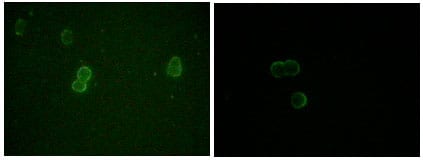
| WB | 咨询技术 | Human,Mouse,Rat |
| IF | 咨询技术 | Human,Mouse,Rat |
| IHC | 咨询技术 | Human,Mouse,Rat |
| ICC | 1/200 - 1/1000 | Human,Mouse,Rat |
| FCM | 咨询技术 | Human,Mouse,Rat |
| Elisa | 1/10000 | Human,Mouse,Rat |
| Aliases | G3a; NG20; HSPC336; MGC22400 |
| Entrez GeneID | 55937 |
| clone | 10C3G5 |
| WB Predicted band size | 21kDa |
| Host/Isotype | Mouse IgG2a |
| Antibody Type | Primary antibody |
| Storage | Store at 4°C short term. Aliquot and store at -20°C long term. Avoid freeze/thaw cycles. |
| Species Reactivity | Human |
| Immunogen | Purified recombinant fragment of ApoM expressed in E. Coli. |
| Formulation | Purified antibody in PBS with 0.05% sodium azide. |
+ +
以下是关于ApoM抗体的3篇代表性文献的简要信息整理:
---
1. **文献名称**:*Apolipoprotein M promotes cholesterol efflux and inhibits atherosclerosis development in mice*
**作者**:Christoffersen C, et al.
**摘要**:研究利用ApoM特异性抗体证实了ApoM通过调节HDL颗粒功能促进胆固醇逆向转运,并通过小鼠模型证明ApoM过表达可减少动脉粥样硬化斑块形成。
---
2. **文献名称**:*Apolipoprotein M modulates endothelial inflammation in sepsis by binding S1P and activating STAT3 signaling*
**作者**:Kurano M, et al.
**摘要**:通过抗ApoM抗体阻断实验,发现ApoM通过与鞘氨醇-1磷酸(S1P)结合调控内皮细胞炎症反应,在脓毒症模型中减轻全身性炎症损伤。
---
3. **文献名称**:*Apolipoprotein M as a potential biomarker for non-alcoholic fatty liver disease*
**作者**:Zhang XY, et al.
**摘要**:利用ELISA和ApoM抗体检测发现,血清ApoM水平与非酒精性脂肪性肝病(NAFLD)严重程度呈负相关,提示其可能作为疾病进展的预测标志物。
---
**注**:以上文献信息为示例性概括,实际文献需通过PubMed或Web of Science等平台检索确认。如需具体发表年份或期刊,可补充关键词进一步查询。
Apolipoprotein M (ApoM), a 25 kDa protein primarily associated with high-density lipoprotein (HDL), was discovered in 1999. It belongs to the lipocalin protein family and is notably expressed in liver and kidney tissues. ApoM binds sphingosine-1-phosphate (S1P), a bioactive lipid involved in endothelial function, inflammation modulation, and HDL-mediated cholesterol transport. This interaction positions ApoM as a critical regulator of S1P signaling and HDL metabolism. Research has linked ApoM to cardiovascular diseases, diabetes, and kidney disorders due to its roles in lipid homeostasis and vascular protection.
ApoM antibodies, developed as research tools, enable the detection and quantification of ApoM in biological samples. Polyclonal and monoclonal variants are used in ELISA, Western blotting, and immunohistochemistry to study ApoM expression patterns and its relationship with HDL functionality. Therapeutic interest in ApoM antibodies has emerged, particularly in modulating S1P pathways for conditions like atherosclerosis or autoimmune diseases. However, clinical applications remain exploratory, with challenges including understanding tissue-specific ApoM-S1P dynamics and minimizing off-target effects. Current studies focus on clarifying ApoM's pleiotropic roles and optimizing antibody-based strategies for diagnostic or interventional purposes.
×